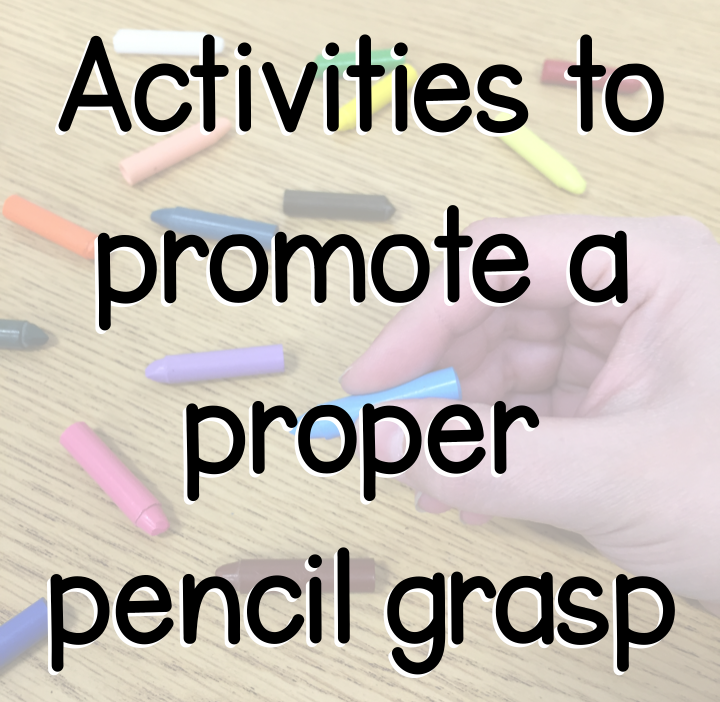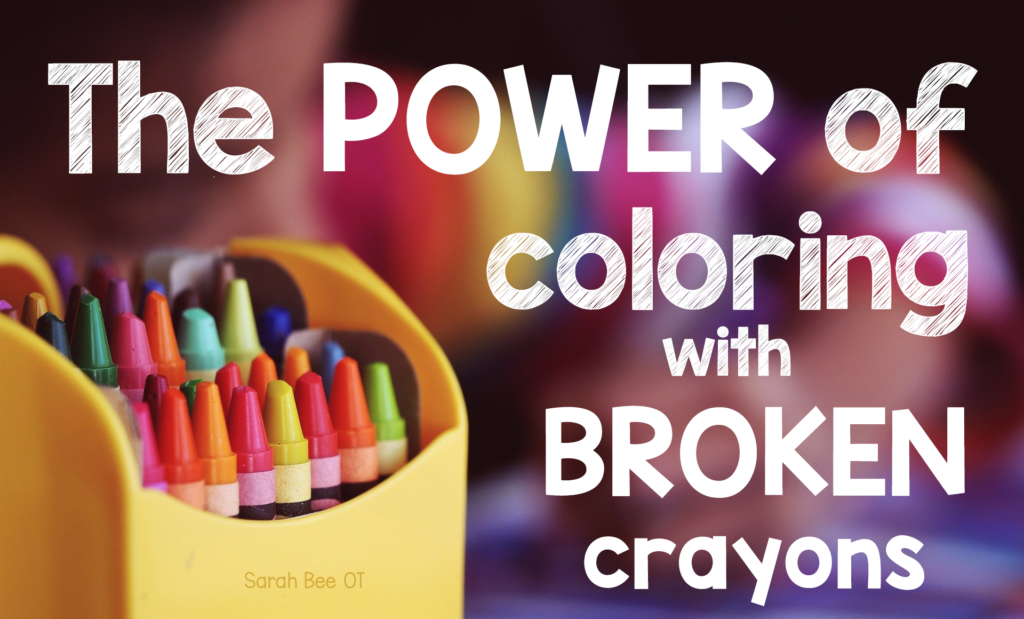Is there anything more satisfying than opening up a brand new box of crayons for the first time? The crisp cardboard, the bright colors, the familiar smell… I love all of it! But you know what I love even more? BROKEN crayons.
That’s right! The snapped-in-half, missing-the-label, forever forgotten crayons that sit lonely at the bottom of the box. They’re like colorful nuggets of wax-based gold for us pediatric OTs!
Why, you ask? What’s the big deal? Why are we so obsessed?
The answer lies in the way that our hands hold them.
You see, broken crayons (especially pieces about 1” in size) are the perfect coloring utensils for facilitating a tripod pencil grasp. The term “tripod” here refers to using the tips of the thumb, index, and middle finger to hold and control the utensil. This grasp is often recognized as being the “proper” grasp.
It’s important to note, however, that the tripod grasp is NOT the only functional grasp out there. Children can develop other common functional grasps such as a lateral tripod, quadripod, or lateral quadripod grasp. All of these grasps allow efficient, dynamic control of utensils- a skill that is needed in more advanced fine motor tasks such as handwriting.

The path towards achieving one of these mature pencil grasps all begins when a child starts experimenting with crayons and markers around the age of 12-18 months. At this age, they hold utensils with their whole hand as they scribble and make marks on paper. From there, they continue through a developmental progression of different transitional grasps until they finally settle on a mature grasp (I will speak more about this process in a future blog post).
While many children will move through this grasp progression naturally as they participate in activities to develop their fine motor skills, for some it doesn’t come so easily. They may get stuck in a pattern of using an immature grasp, or they might adopt an inefficient grasp. An inefficient pencil grasp is one that causes pain, fatigue, or restricts precise dynamic movement of the fingertips.
How does coloring with broken crayons help?
Broken crayon pieces help to prevent these issues from happening. Not only are they easier for small hands to manage, but they also make it very difficult for less mature or inefficient grasp patterns to exist. Their small size gives us no other choice but to hold them with our fingertips. Over time, our fingers become familiar with this grasp pattern and so the tripod grasp is reinforced.
In addition to grasp development, broken crayons are also great for building strength in the small muscles of the hand. You can use them in the same ways you would use whole crayons, or you can use them during some of my favorite activities below:

Rainbow tracing:
Practice drawing shapes, numbers, or letters by tracing over the same path repeatedly with a variety of different colored broken crayons. This is a great way to work on visual motor control and learn motor patterns for number and letter formation. Plus, who doesn’t love rainbow colors?!
Coloring on vertical surfaces:
Another activity occupational therapists love is coloring on vertical surfaces such as walls or easels. This helps to promote wrist extension, which in turn promotes a more efficient utensil grasp. It also works on upper body strengthening as your child is working against gravity to color. If you don’t have an easel, protect your wall paint by taping a large square of old newspaper or poster board to the wall first, then tape a coloring page on top of it. For an added challenge, forgo the tape on the coloring page and have your child hold it against the vertical surface with their non-dominant “helper” hand.
Crayon rubbing art:
Set a blank piece of paper on top of a textured surface (sandpaper, leaves, coins, etc.). Lay the crayon flat on top of the paper, pinch it, and then rub it back and forth over the surface. As the crayon rubs across the surface, the underlying texture begins to appear on the paper. This activity is especially good for fine motor strengthening as your child will have to press the crayon with enough force to expose the texture underneath. It also sneaks in some additional bilateral coordination practice as they work hard at stabilizing the paper with their non-dominant hand.

